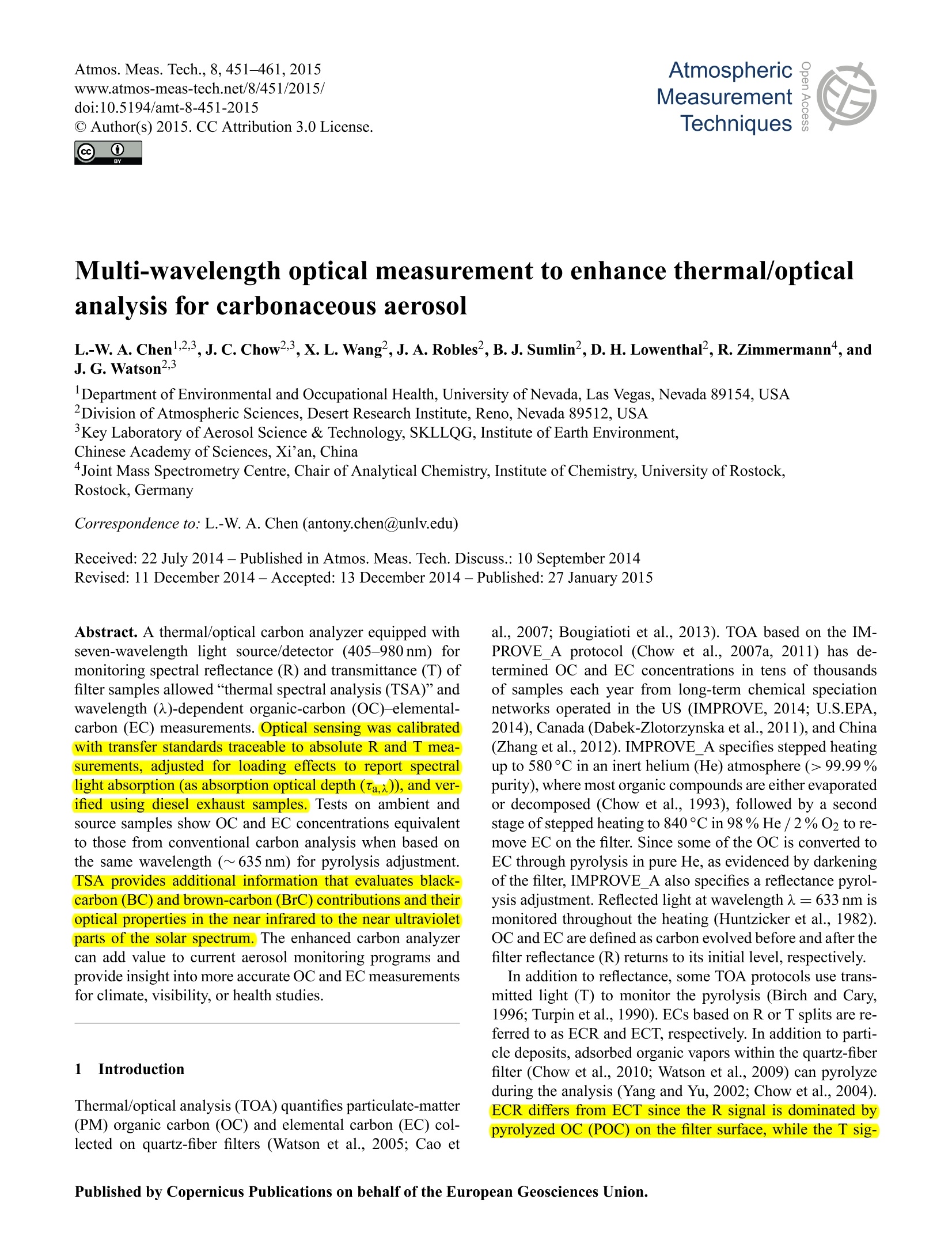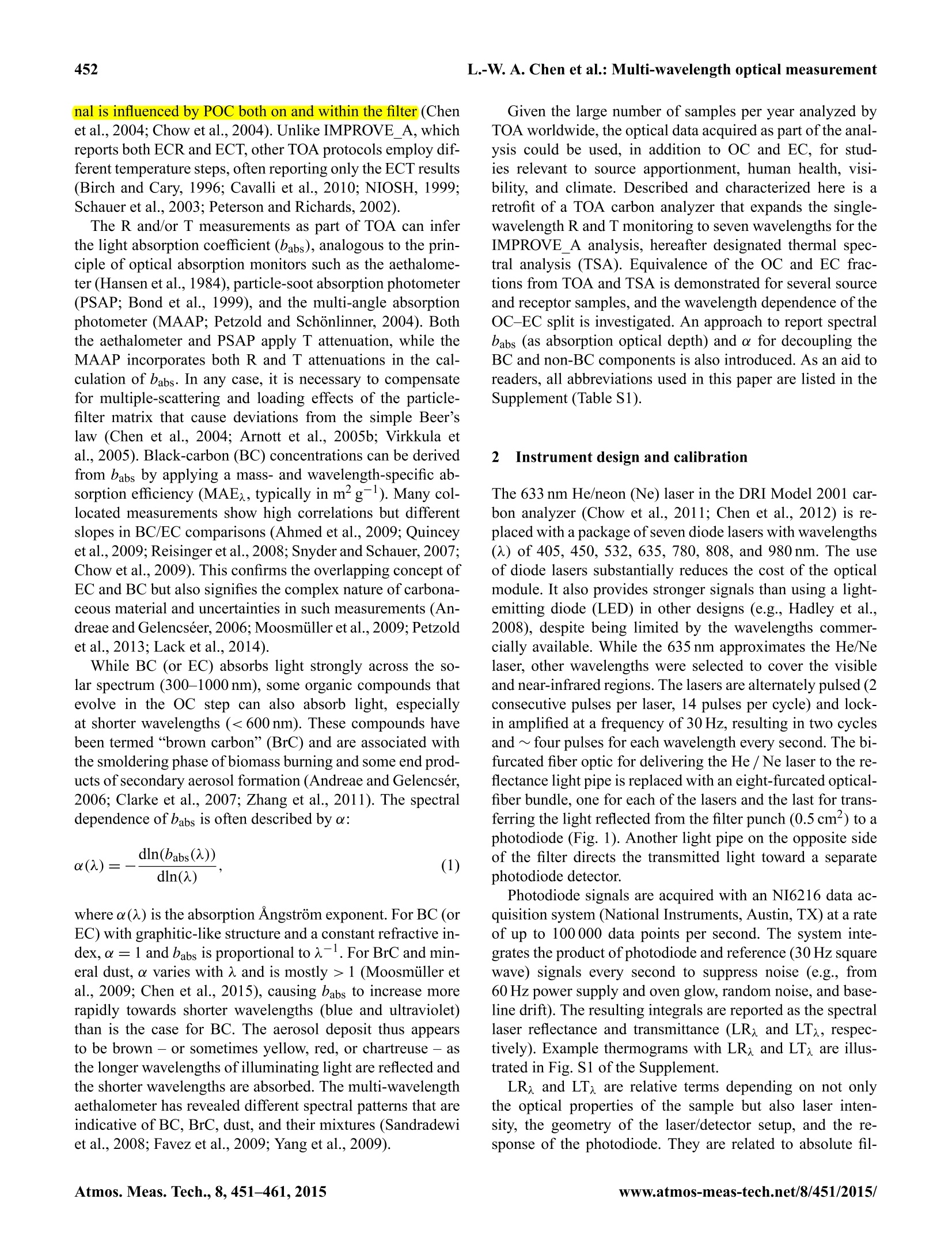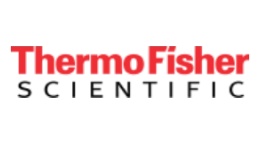方案详情文
智能文字提取功能测试中
AtmosphericAtmos. Meas. Tech., 8, 451-461,2015Measurementwww.atmos-meas-tech.net/8/451/2015/doi:10.5194/amt-8-451-2015Techniques@ Author(s) 2015. CC Attribution 3.0 License. L.-W. A. Chen et al.:Multi-wavelength optical measurement452 Multi-wavelength optical measurement to enhance thermal/opticalanalysis for carbonaceous aerosol L.-W. A. Chen123, J. C. Chow2.3, X. L. Wang?, J. A. Robles,B. J. Sumlin, D. H. Lowenthal, R. Zimmermannt, andJ.G. Watson23 'Department of Environmental and Occupational Health, University of Nevada, Las Vegas, Nevada 89154, USA Division of Atmospheric Sciences, Desert Research Institute, Reno, Nevada 89512, USA Key Laboratory of Aerosol Science & Technology, SKLLQG, Institute of Earth Environment, Chinese Academy of Sciences, Xi’an,China “Joint Mass Spectrometry Centre, Chair of Analytical Chemistry, Institute of Chemistry, University of Rostock,Rostock, Germany Correspondence to: L.-W. A. Chen (antony.chen@unlv.edu) Received: 22 July 2014 -Published in Atmos. Meas. Tech. Discuss.: 10 September 2014 Revised: 11 December 2014- Accepted: 13 December 2014-Published:27 January 2015 Abstract. A thermal/optical carbon analyzer equipped withseven-wavelength light source/detector (405-980nm) formonitoring spectral reflectance (R) and transmittance (T) offilter samples allowed“thermal spectral analysis (TSA)”andwavelength ()-dependent organic-carbon (OC)-elemental-carbon (EC) measurements.(. Optical sensing was calibratedwith transfer standards traceable to absolute R and T mea-surements, adjusted for loading effects to report spectrallight absorption (as absorption optical depth (ta,x)), and ver-ified using diesel exhaust samples.Tests on ambient andsource samples show OC and EC concentrations equivalentto those from conventional carbon analysis when based onthe same wavelength (~635nm) for pyrolysis adjustment.TSA provides additional information that evaluates black-carbon (BC) and brown-carbon (BrC) contributions and theiroptical properties in the near infrared to the near ultravioletparts of the solar spectrum.. The enhanced carbon analyzercan add value to current aerosol monitoring programs andprovide insight into more accurate OC and EC measurementsfor climate, visibility, or health studies. 1 Introduction Thermal/optical analysis (TOA) quantifies particulate-matter(PM) organic carbon (OC) and elemental carbon (EC) col-lected on quartz-fiber filters (Watson et al., 2005; Cao et al., 2007; Bougiatioti et al., 2013). TOA based on the IM-PROVE_A protocol (Chow et al., 2007a, 2011) has de-termined OC and EC concentrations in tens of thousandsof samples each year from long-term chemical speciationnetworks operated in the US (IMPROVE, 2014; U.S.EPA,2014), Canada (Dabek-Zlotorzynska et al., 2011), and China(Zhang et al.,2012). IMPROVE_A specifies stepped heatingup to 580°C in an inert helium (He) atmosphere (>99.99%purity), where most organic compounds are either evaporatedor decomposed (Chow et al., 1993), followed by a secondstage of stepped heating to 840°C in 98% He /2% 02 to re-move EC on the filter. Since some of the OC is converted toEC through pyrolysis in pure He, as evidenced by darkeningof the filter, IMPROVE_A also specifies a reflectance pyrol-ysis adjustment. Reflected light at wavelength 入=633 nm ismonitored throughout the heating (Huntzicker et al., 1982).OC and EC are defined as carbon evolved before and after thefilter reflectance (R) returns to its initial level, respectively. In addition to reflectance, some TOA protocols use trans-mitted light (T) to monitor the pyrolysis (Birch and Cary,1996; Turpin et al., 1990). ECs based on R or T splits are re-ferred to as ECR and ECT, respectively. In addition to parti-cle deposits, adsorbed organic vapors within the quartz-fiberfilter (Chow et al., 2010; Watson et al., 2009) can pyrolyzeduring the analysis (Yang and Yu, 2002; Chow et al., 2004).ECR differs from ECT since the R signal is dominated bypyrolyzed OC (POC) on the filter surface, while the T sig- Published by Copernicus Publications on behalf of the European Geosciences Union. nal is influenced by POC both on and within the filter (Chenet al., 2004; Chow et al., 2004).Unlike IMPROVE A, whichreports both ECR and ECT, other TOA protocols employ dif-ferent temperature steps, often reporting only the ECT results(Birch and Cary, 1996; Cavalli et al., 2010; NIOSH, 1999;Schauer et al., 2003; Peterson and Richards,2002). The R and/or T measurements as part of TOA can inferthe light absorption coefficient (babs), analogous to the prin-ciple of optical absorption monitors such as the aethalome-ter (Hansen et al., 1984), particle-soot absorption photometer(PSAP; Bond et al., 1999), and the multi-angle absorptionphotometer (MAAP; Petzold and Schonlinner, 2004). Boththe aethalometer and PSAP apply T attenuation, while theMAAP incorporates both R and T attenuations in the cal-culation of babs. In any case, it is necessary to compensatefor multiple-scattering and loading effects of the particle-filter matrix that cause deviations from the simple Beer’slaw (Chen et al., 2004; Arnott et al., 2005b; Virkkula etal., 2005). Black-carbon (BC) concentrations can be derivedfrom babs by applying a mass- and wavelength-specific ab-sorption efficiency (MAEx, typically in m’g-). Many col-located measurements show high correlations but differentslopes in BC/EC comparisons (Ahmed et al., 2009;Quinceyet al., 2009; Reisinger et al., 2008; Snyder and Schauer, 2007;Chow et al.,2009). This confirms the overlapping concept ofEC and BC but also signifies the complex nature of carbona-ceous material and uncertainties in such measurements (An-dreae and Gelencseer, 2006; Moosmiiller et al., 2009;Petzoldet al., 2013; Lack et al., 2014). While BC (or EC) absorbs light strongly across the so-lar spectrum (300-1000nm), some organic compounds thatevolve in the OC step can also absorb light, especiallyat shorter wavelengths (<600 nm). These compounds havebeen termed“brown carbon”(BrC) and are associated withthe smoldering phase of biomass burning and some end prod-ucts of secondary aerosol formation (Andreae and Gelencser,2006; Clarke et al., 2007; Zhang et al., 2011). The spectraldependence of babs is often described by a: where (入) is the absorption Angstrom exponent. For BC (orEC) with graphitic-like structure and a constant refractive in-dex, a= 1 and babs is proportional to -1. For BrC and min-eral dust, a varies with A and is mostly >1 (Moosmiller etal., 2009; Chen et al., 2015), causing babs to increase morerapidly towards shorter wavelengths (blue and ultraviolet)than is the case for BC. The aerosol deposit thus appearsto be brown- or sometimes yellow, red, or chartreuse - asthe longer wavelengths of illuminating light are reflected andthe shorter wavelengths are absorbed. The multi-wavelengthaethalometer has revealed different spectral patterns that areindicative of BC, BrC, dust, and their mixtures (Sandradewiet al., 2008; Favez et al., 2009; Yang et al., 2009). Given the large number of samples per year analyzed byTOA worldwide, the optical data acquired as part of the anal-ysis could be used, in addition to OC and EC, for stud-ies relevant to source apportionment, human health, visi-bility, and climate. Described and characterized here is aretrofit of a TOA carbon analyzer that expands the single-wavelength R and T monitoring to seven wavelengths for theIMPROVE_A analysis, hereafter designated thermal spec-tral analysis (TSA). Equivalence of the OC and EC frac-tions from TOA and TSA is demonstrated for several sourceand receptor samples, and the wavelength dependence of theOC-EC split is investigated. An approach to report spectralbabs (as absorption optical depth) and a for decoupling theBC and non-BC components is also introduced. As an aid toreaders, all abbreviations used in this paper are listed in theSupplement (Table S1). 2 Instrument design and calibration The 633 nm He/neon (Ne) laser in the DRI Model 2001 car-bon analyzer (Chow et al., 2011; Chen et al., 2012) is re-placed with a package of seven diode lasers with wavelengths(入) of 405, 450,532,635,780,808, and 980nm. The useof diode lasers substantially reduces the cost of the opticalmodule. It also provides stronger signals than using a light-emitting diode (LED) in other designs (e.g., Hadley et al.,2008), despite being limited by the wavelengths commer-cially available. While the 635 nm approximates the He/Nelaser, other wavelengths were selected to cover the visibleand near-infrared regions. The lasers are alternately pulsed (2consecutive pulses per laser, 14 pulses per cycle) and lock-in amplified at a frequency of 30 Hz, resulting in two cyclesand ~ four pulses for each wavelength every second. The bi-furcated fiber optic for delivering the He /Ne laser to the re-flectance light pipe is replaced with an eight-furcated optical-fiber bundle, one for each of the lasers and the last for trans-ferring the light reflected from the filter punch (0.5 cm) to aphotodiode (Fig. 1). Another light pipe on the opposite sideof the filter directs the transmitted light toward a separatephotodiode detector. Photodiode signals are acquired with an NI6216 data ac-quisition system (National Instruments, Austin,TX) at a rateof up to 100000 data points per second. The system inte-grates the product of photodiode and reference (30Hz squarewave) signals every second to suppress noise (e.g., from60 Hz power supply and oven glow, random noise, and base-line drift). The resulting integrals are reported as the spectrallaser reflectance and transmittance (LRx and LTx, respec-tively). Example thermograms with LR and LT are illus-trated in Fig. S1 of the Supplement. LR and LT are relative terms depending on not onlythe optical properties of the sample but also laser inten-sity, the geometry of the laser/detector setup, and the re-sponse of the photodiode. They are related to absolute fil- Figure 1. Configuration of optical sensing (left) modified from the DRI Model 2001 analyzer (Chen et al.,2012). The seven-laser module(i.e., L1-L7) represents seven diode lasers with wavelengths of 405, 450,532,635,780,808, and 980 nm. Reference (top right) and laser(middle right) signals are modulated at 30 Hz for a lock-in amplification of the reflectance or transmittance signals (bottom right). Only 30 Hzsignals with the same phase as the reference are amplified at gains proportional to the reference signal voltage and number of data pointsintegrated. ter reflectance and transmittance (FRx and FT,i.e., frac-tion of light reflected from or transmitted through the fil-ter, respectively), using a set of transfer standards con-sisting of eight PM2.5 quartz-fiber filters acquired usinghigh-volume samplers from the Fresno Supersite (Watsonet al., 2000; Chow et al., 2009), with EC loadings rangingfrom 0.9 to 15.8 ug cm-2 (Fig. S2). The high-volume filters(406 cm) represent well-characterized urban aerosol, whileproviding sufficient sample for extensive testing. FR andFT of the transfer standards were predetermined using anintegrating-sphere spectrometer (Lambda 35, Perkin Elmer,Massachusetts, USA; see, e.g., Zhong and Jang, 2011; Chenet al.,2015) traceable to NIST (National Institute of Standardand Technology) standards for wavelengths between 300 and1000 nm. Figure 2 compares LR and LT with FR and FT, re-spectively, for the transfer standards. Within the range ofFR,(0.1-0.8) and FTx (0.0001-0.1), highly significant linear re-lationships (r²>0.9) demonstrate the stability of the LR;and LT measurements and the feasibility of converting themto FR and FT through calibration with a standardized spec-trometer. Figure S1 illustrates the changes in FR and FTx,retrieved from LR and LT, throughout a typical TSA. Theuncertainty of the FR and FT retrievals may be evaluatedby the coefficient of variance of the root mean square resid-ual (CV-RMSR) in the FRx /LR and FT /LTregression,respectively: where Yobs is the FRx or FT measured by the integrating-sphere spectrometer, Ycal is the FRx or FTx calculated fromLR, or LT, respectively, and n is the number of samples.FR633 nm and FT633 nm based on the He / Ne laser ofa typi-cal Model 2001 analyzer exhibit a~3% uncertainty (Fig. 2).For this retrofit, FR uncertainties range from 3 to 11% andFT uncertainties range from 5 to 18 %, with the best preci-sion shown at 450 and 808 nm. The divergence in uncertaintyis attributed to the quality of the laser and the sensitivity ofthe photodiode detector for different wavelengths. Ongoingefforts to improve the signal-to-noise ratio of R and T mea-surements by using different lasers and averaging algorithmswill be documented in subsequent papers. 3 Consistency of the OC-EC split Several source and ambient PM2.5 samples (Table 1) areused for testing the system. Samples from the Fresno Super-site (2 April 2003-28 December 2003) contain a mixture ofcarbonaceous materials from fresh engine exhaust, biomassburning, and cooking (Chen et al., 2007; Chow et al., 2007b;Gorin et al., 2006; Schauer and Cass, 2000). Reno ambi-ent samples were acquired during the period of Rim Fire(17 August 2013-24 October 2013) and are dominated byan aged biomass burning plume containing mixed flamingand smoldering emissions. Source testing as part of the LakeTahoe Prescribed Burning Study (Malamakal et al., 2013)and Gasoline/Diesel Split Study (Fujita et al., 2007) providedpure biomass burning and diesel exhaust samples, respec- Table 1. Comparison of TC, OCR, OCT, ECR, and ECT between the 633 nm (TOA) and 635 nm (TSA) optical splits following the IM-PROVE_A protocol. Sampletype Corr. Sampletype Optical split (nm) Sample no. and avg. Corr. Deming regression: y=m×x+b RD:2(y-x)/(y+x) y 71 2 m(±1od) b(±1od) mean±1o p TC Fresno Supersite 635 633 10 20.30 20.05 1.00 0.97±0.05 0.38±0.75 -0.01±0.04 0.56 Reno wildfire 635 633 14 30.69 30.21 1.00 0.91±0.06 2.14±1.18 0.04±0.09 0.15 Prescribed burn 635 633 9 19.27 20.11 1.00 1.06±0.09 -0.32±1.12 0.01±0.14 0.91 Diesel exhaust 635 633 11 8.10 7.78 0.97 0.99±0.05 -0.26±0.48 -0.06十0.15 0.21 All 635 633 44 20.34 20.23 0.99 0.95±0.07 0.89±1.00 0.00±0.12 0.85 OCR Fresno Supersite 635 633 10 16.02 15.91 0.99 0.97±0.06 0.44十0.76 0.00±0.05 0.85 Reno wildfire 635 633 14 27.62 26.99 1.00 0.90±0.07 2.09±1.27 0.03±0.09 0.30 Prescribed burn 635 633 9 17.22 18.25 1.00 1.07±0.06 -0.12±0.76 0.03±0.13 0.65 Diesel exhaust 635 633 11 4.08 3.91 0.52 0.95±0.35 0.04±1.35 -0.04±0.17 0.46 All 635 633 44 16.97 16.91 0.99 0.94±0.08 0.90±0.99 0.00±0.12 0.68 OCT Fresno Supersite 635 633 10 17.80 17.82 1.00 1.01±0.03 -0.17±0.43 0.00±0.04 0.85 Reno wildfire 635 633 14 29.07 28.64 1.00 0.92±0.06 1.93±1.19 0.03±0.08 0.14 Prescribed burn 635 633 9 18.11 18.92 1.00 1.07±0.05 -0.37±0.72 0.01±0.13 0.65 Diesel exhaust 635 633 11 4.42 4.14 0.46 1.01±0.46 -0.33±1.91 -0.07±0.20 0.32 All 635 633 44 18.10 18.07 0.99 0.96±0.07 0.74±0.94 -0.01±0.13 0.75 ECR Fresno Supersite 635 633 10 4.28 4.15 1.00 0.99±0.06 -0.11±0.17 -0.06±0.08 0.06 Reno wildfire 635 633 14 3.07 3.22 0.99 1.04十0.07 0.02±0.15 0.12±0.23 0.14 Prescribed burn 635 633 9 2.05 1.86 0.88 0.92±0.18 -0.03±0.34 -0.13±0.25 0.25 Diesel exhaust 635 633 11 4.02 3.87 0.99 0.97±0.07 -0.03±0.23 -0.17±0.30 0.12 All 635 633 44 3.37 3.31 0.99 1.00±0.03 -0.05±0.08 -0.04±0.25 0.17 ECT Fresno Supersite 635 633 10 2.50 2.23 0.99 0.78±0.12 0.29±0.22 -0.07±0.14 0.13 Reno wildfire 635 633 14 1.62 1.57 0.98 TC: total carbon; OCR: organic carbon by reflectance; OCT: organic carbon by transmittance; ECR: elemental carbon by reflectance; and ECT: elemental carbon by transmittancefollowing the IMPROVE_A thermal/optical carbon analysis protocol (Chow et al., 2007a). TOA: thermal/optical analyses; TSA: thermal/spectral analyses. x is by retrofittedseven-wavelength carbon analyzer; y is by conventional single-wavelength (633 nm) DRI Model 2001 thermal/optical carbon analyzer. Concentration in ug cm-2;m is the slope; b is theintercept in pug cm-2. d o: standard deviation. Student’s t test p values. tively. All these samples were analyzed by both TSA (usingthe retrofit) and TOA (using conventional Model 2001 ana-lyzers) following the IMPROVE_A protocol. Table 1 compares total carbon (TC), OC, and EC by re-flectance (i.e., OCR and ECR) and transmittance (i.e., OCTand ECT) between TSA with the 635 nm and TOA with thenormal 633 nm OC-EC split. As expected, TC is equiva-lent, with the averages agreeing within ±5% and regressionslopes (m) ranging from 0.91 and 1.06 for each of the foursample types. The relative difference (RD), defined as the ra-tio of the difference divided by the average of two measure-ments (i.e., TSA and TOA) on the same sample, does notdiffer from 0 at the 5% significance level (p >0.05). The standard deviations of RD, a measure of random error, arehigher for source (14-15%) than for ambient (4-9%) sam-ples, indicative of greater deposit inhomogeneity for thesesamples, possibly due to variable sampling conditions overshort sampling durations. TSA and TOA also yield statistically equivalent OC andEC results, either by R or T (Table 1). Figure 3 visualizes thecomparisons. With respect to the standard deviation of RD,OCR and OCT are similar to TC, while ECR and ECT arehigher (up to 33%) due to a lower fraction of EC in TC. Bycategory average, ECR and ECT account for 10-50 and 5-46% ofTC, respectively. In general, ECR > ECT, as reportedin previous studies (Khan et al., 2012; Han et al., 2013;Chow Figure 2. Calibration of spectral laser (a, b) reflectance and (c, d)transmittance measurements (LRand LTx, respectively, in milli-volts (mV)) from the retrofitted seven-wavelength carbon analyzerat room temperature against absolute filter reflectance and trans-mittance (FR) and FT, respectively) quantified by the Lambdaintegrating-sphere spectrometer, using eight Fresno ambient sam-ples (5/6, 6/6,6/19,7/3,9/29,11/4, 11/13, and 12/28 of 2003)of various loadings as transfer standards. The 633 nm data are froma conventional carbon analyzer. r2 and CV-RMSR evaluate the re-gression performance. et al., 2001;Schmid et al., 2001), consistent with organic va-pors pyrolyzed within the filter leaving the sample after na-tive EC and POC in the surface deposit have evolved (Chenet al., 2004). POC was least apparent for the diesel exhaustsamples where optical adjustments were negligible. The basic assumptions for optical adjustment include thefollowing: (1)OC does not absorb light and (2) POC hasthe same apparent MAE as EC. Within-the-filter POC showsno apparent MAE by R (i.e., cannot detect it for any wave-lengths) but high MAEs by T (higher than EC due to amultiple-scattering effect (Chow et al., 2004; Subramanianet al., 2006)). This leads to divergent ECR and ECT re-sults. Since the multiple-scattering effect is larger for shorterwavelengths, ECT is expected to decrease with the wave-length at which the split is made. On the other hand, Chow etal. (1993) observed that the operational definition for EC byany TOA protocol might contain some light-absorbing OC.BrC, if present, would lower the baselines ofR and T (priorto thermal analysis) for shorter wavelengths, resulting in ear-lier split points and larger EC reported than that from longerwavelengths. Table 2 compares OC-EC splits for 635nm with splitsderived from shorter (450 nm) and longer (808 nm) wave- 100 Figure 3. Comparison of organic and elemental carbon by re-flectance optical correction (i.e., OCR and ECR, respectively) be-tween the conventional thermal/optical analysis (TOA based on633 nm optical split) and seven-wavelength thermal/spectral analy-sis (TSA based on 635 nm optical split) following the IMPROVE_Aprotocol. Note that x and y axes are on log scales. lengths that have the lowest LR or LT uncertainties. ECRsbased on the 635 nm split agree well with those based on the808 nm split (i.e., slopes within the standard error from unityand p(RD)>0.02) for all the sample types. This demon-strates that the 633 nm R split commonly used for opticaladjustment since Huntzicker et al. (1982) does not signif-icantly respond to BrC absorption compared with longervisible or infrared wavelengths. For ECT, the 880 nm splityielded higher values than the 635 nm split, especially forbiomass-burning-dominated samples. This is consistent withECT being influenced by POC within the filter and decreas-ing ECT with decreasing wavelength. The 450 nm split appears to be sensitive to BrC content, asevidenced by larger ECR than those determined with 635 nm(except for diesel exhaust samples, where BrC contents arelow). The difference is largest for the aged Reno wildfiresamples, which may also contain some secondary organicaerosol formed during transport over the 200 km distance be-tween Yosemite National Park and Reno, Nevada. As demon-strated in Fig.S1, shorter wavelengths produce earlier splits,resulting in higher ECR concentrations. The increase ofECTdue to a 450 nm optical correction is not evident, which maybe due to the opposing effects of BrC and POC at the shorterwavelength. Table 2. Comparison of TSA-determined 635 nm ECR and ECT with 880 nm and 450 nm following the IMPROVE_A protocol. Sample type Optical split (nm)a Sample no. and avg. Corr. Deming regression: y=m×x+b RD:2(y-x)/(y+x) y x y ,2 m(±1o°) b(±1o°) mean± 1o pd ECR Fresno Supersite 635 450 10 4.28 4.74 1.00 1.23±0.04 -0.55±0.13 0.01±0.13 0.82 Reno wildfire 635 450 14 3.07 4.29 0.95 1.90±0.58 -1.55±1.24 0.14±0.25 0.06 Prescribed burn 635 450 9 2.05 2.14 0.98 1.41±0.23 -0.74±0.39 -0.03±0.16 0.57 Diesel exhaust 635 450 11 4.02 3.93 1.00 1.00±0.01 -0.10±0.06 -0.08±0.11 0.06 All 635 450 44 3.37 3.86 0.90 1.36±0.28 -0.71±0.66 0.02±0.19 0.76 Fresno Supersite 635 808 10 4.28 4.12 1.00 0.95±0.08 0.06±0.22 -0.05±0.05 0.03 Reno wildfire 635 808 14 3.07 3.22 1.00 1.04±0.08 0.03±0.17 0.15±0.23 0.02 Prescribed burn 635 808 9 2.05 2.12 0.99 1.00±0.09 0.06±0.17 0.03±0.09 0.30 Diesel exhaust 635 808 11 4.02 4.00 1.00 1.00±0.00 -0.02±0.02 -0.01十0.02 1.00 All 635 808 44 3.37 3.40 1.00 0.99±0.03 0.05±0.07 0.04±0.16 0.19 ECT Fresno Supersite 635 450 10 2.50 2.44 1.00 1.00±0.02 -0.05±0.07 -0.04±0.08 0.16 Reno wildfire 635 450 14 1.62 1.35 0.99 0.85±0.06 -0.02±0.06 -0.20±0.14 0.00 Prescribed burn 635 450 9 1.16 1.07 0.98 1.06±0.25 -0.16±0.22 -0.08±0.24 0.16 Diesel exhaust 635 450 11 3.68 3.59 1.00 0.97±0.01 0.01±0.04 -0.04土0.06 0.07 All 635 450 44 2.24 2.10 0.99 0.97±0.02 -0.08±0.03 -0.10±0.16 0.00 Fresno Supersite 635 808 10 2.50 2.67 1.00 1.03±0.04 0.10±0.08 0.08±0.04 0.00 Reno wildfire 635 808 14 1.62 2.00 0.99 1.24±0.04 -0.01±0.08 0.18±0.18 0.00 Prescribed burn 635 808 9 1.16 1.27 0.99 1.10±0.12 -0.01±0.12 -0.09±0.60 0.13 Diesel exhaust 635 808 11 3.68 3.53 1.00 0.99±0.01 -0.11±0.07 -0.24±0.41 0.01 All 635 808 44 2.24 2.38 0.99 1.01±0.07 0.11±0.12 0.00±0.38 0.02 a x and y are both by modified seven-wavelength carbon analyzer but with optical pyrolysis adjustment at different wavelengths. Concentration in ug cm-2; m is the slope; b is theintercept in pgcm-2. Co: standard deviation. Student’s t test p values. Multi-wavelength absorption retrieval Light absorption by particles on the filter is often estimatedby transmittance attenuation (ATN): where i and f indicate FT measured before and after ther-mal analysis, respectively. FTa,f approximates a blank fil-ter since all of the carbon has been removed. ATN includesscattering and absorption within the substrate. On the otherhand, the absorption optical depth (ta,) measures only thelight absorption. For diesel soot samples with negligible BrCand POC. where [EC] is the areal concentration of EC on filter inugcm-2. If there were no filter effects, ATN and ta wouldbe identical for a given 入 as described by Beer’s law. Withthe knowledge of sampling volume (V) and filter area (A),ambient babs can be calculated from taxA/V. The relationship of [EC] and ATN635 nm throughout theEC2 step (740°C in a 98% He /2%02 atmosphere) of the IMPROVE_A analysis for a diesel exhaust sample is shownin Fig. 4. Since in this case carbon evolved during EC2 is ex-clusively EC, the temporal variation in [EC], i.e., d[EC]/dt,can be determined from carbon released and detected by thecarbon analyzer. Arnott et al. (2005b) proposed a quadraticrelationship between [EC] and ATN, derived from and thus where M. and Bx. account for the wavelength-specificmultiple-scattering and loading effects, respectively. Eq. (6)fits the relationship in Fig. 4 well (r²>0.99), thereby al-lowing M and B to be estimated. EC (quantified by IM-PROVE_A ECR or ECT) of all the diesel exhaust sam-ples exhibits a consistent dependence on the initial sampleATN635 nm (prior to TSA) (Fig. 4). This supports the use ofATN635 nm as a surrogate for EC and light absorption. Simi- Figure 4. Relationship of EC concentration, [EC],, versusATN635 nm from all 1 s measurements during the EC2 step (740°Cin a 98% He /2% 02 atmosphere) of IMPROVE_A analysis for adiesel exhaust sample (CIFQ074 from the Gas/Diesel Split Study(Fujita et al.,2007)). Also shown are paired [EC]-ATN635 nm of 11diesel exhaust samples, where EC is determined from IMPROVEAand ATN635 nm from initial filter transmittance. Circles and er-ror bars indicate the average and spread, respectively, of EC bytransmittance and reflectance (i.e., ECT and ECR, respectively).ta.635 nm was further calculated from a MAE of7.4mg×[EC],and the regression result between ta,635 nm and ATN635 nm isshown in green. lar relationships hold between [EC] and ATN for other wave-lengths (Fig. S3). The largest scatter observed for 532 nmcorresponds to the highest uncertainty in FT532 nm retrievals;it results from the slow laser response time to modulation andthe low sensitivity of the transmittance photodiode detectorat this wavelength, which will be addressed in a subsequentdesign of the retrofit optics. To relate:ta.635 nmnto ATN635 nm, aaMAE (EC) of7.4m²g-1 at 635 nm was used. The MAE was derivedfrom concurrent babs, by a photoacoustic sensor at 1047 nm,and EC, by IMPROVE_A, measurements during the Gaso-line/Diesel Split Study (Arnott et al., 2005a) and assumingan a of 1 in Eq.(1). The quadratic relationship holds for allof the available wavelengths, as seen in Fig. 5. Light absorp-tion is enhanced by the filter since any ta,<1 correspondsto a larger ATN, with more amplification towards shorterwavelengths. These ta,-ATN relationships would apply toany samples, regardless of the nature of light-absorbing ma-terial (e.g., EC, BC, BrC, or mineral dust). Particle penetra-tion depth and, to a lesser degree, single-scattering albedoand the asymmetry g factor can influence the ta,-ATN, de-pendence, though for a similar sampling configuration andfilter material/thickness with typical loading, the perturba-tion is expected to be small (Chen et al., 2004; Arnott et al.,2005b). Retrieval algorithms employing both R and T such asthose in Petzold and Schonlinner (2004) should be developedin the future to utilize all the information available. Figure 5. ta,x-ATN relationships for 405-980 nm wavelengths,based on a diesel exhaust reference sample.Results for 532 nm arenot shown owing to lack of sufficient detector signal-to-noise ratioat this wavelength. Figure 6. Product of absorption optical depth (ta,入) and wavelength(A) as a function of 入 by sample type. ta, shown represents aver-ages over each of the sample types. Using the relationships in Fig. 5, ta,) was calculated forall samples from the initially measured ATN values, withthe average ta,×a by sample type compared in Fig. 6.The nearly constant ta, ×入 for diesel exhaust samples, i.e.,ta.oa-1, is consistent with the exclusive contribution ofEC to light absorption. BC derived from the ta, would beequivalent to diesel EC. Averaged ta, ×入 increases by fac-tors of 1.5, 3.0, and 3.9 from 980 to 405 nm for the Fresnoambient, Reno wildfire, and prescribed-burning samples, re-spectively. This reflects different levels of non-EC contribu-tion. Table 3. Average Ta.635 nm for four sample types and their respective BC and BrC fractions, BrC absorption Angstrom exponent, and diesel-EC-equivalent BC (BCa) concentration. IMPROVE_A ECR and ECT determined by the 635 nm optical adjustment are compared to BCa interms of average and p value of the relative difference (RD). Sample type a,635 nm ta,635 nm,BC a,635 nm,BrC gc aBrC BC: ECR ECT p value p value (%in ta) (ugcm (ugcm-2) (ugcm-2) (RDBC.ECR) (RDBC,ECT) Fresno (ambient) 0.33 0.30 0.03(10%) 1 4.8±1.5 4.0 4.3 2.5 0.02 0.87 Reno(wildfire) 0.10 0.07 0.02 (26%) 1 4.8±1.7 1.0 3.1 1.6 0.00 0.00 Prescribed burning 0.04 0.02 0.02 (46%) 1 4.2±1.8 0.3 2.1 1.2 0.00 0.00 Diesel exhausts 0.26 0.26 0.00(1%) 1 2.3±0.1 3.5 4.0 3.7 0.05 0.06 a Pre-assumed values. Calculated from Ta.635 nm.Bc/(7.4m²g-1). 5 Separation of BC and BrC contributions A simplified two-component model consisting of BC andBrC, each with explicit absorption Angstrom exponents (aBcandaBrc), is used to explain the spectral dependence of ta.入in the samples: where qBc and qBrc are fitting coefficients. This is analogousto the approach of Sandradewi et al. (2008), who consideredthe two components to be traffic and wood-burning particlesand Hadley et al. (2008), who modeled two components ofBC and char. Assuming an aBc of 1 the same as diesel EC,then Fitting coefficients in Eq. (8) were obtained for Brc val-ues between 2 and 8 by least-square linear regression, andthe aBrc that led to the overall best fit in terms ofr was se-lected as the effective absorption Angstrom exponent of BrCwith which ta,入,BC and ta,,Brc can be calculated from thefirst and second terms of Eq. (7). This fitting takes advantageof all six wavelengths. For each of the 44 samples, Fig. S4shows that fitted ta, are within ±5% of the measured val-ues for ta,>0.01. Examples of the ta, decomposition as afunction of wavelength are shown in Fig. S5. Table 3 summarizes the apportionment of ta,635 nm intoBC and BrC fractions along with average Brc,“diesel-EC-equivalent”BC (termed BCa hereafter), ECR, and ECT bysample type. Consistent with Fig. 5, BrC contributions tota,635 nm are much higher in prescribed burning than in dieselexhaust samples (averaging 46% versus 1%) while some-where in between (10-26%) for Fresno and Reno wildfiresamples. Effective Brc compares well among Fresno, Renowildfire, and prescribed-burning samples (4.2-4.8) and isconsistent with BrC of a similar nature from biomass burn-ing (Bahadur et al., 2012; Kirchstetter and Thatcher, 2012).Even in the infrared region BrC accounts for 3, 6, and 24% ofta,980 nm for the Fresno, Reno, and prescribed-burning sam-ples, respectively, on average. aBrc in diesel exhaust, de-tectable in 5 of 11 samples, appears to be significantly lower(2.3±0.1) than in other sample types. Table 3 shows that BCad determinedfrom.-1\Ta,635 nm.BC /MAE635 nm (7.4mg-)are lowerthanECR635 nm. The differencesare especially significant(i.e., p value of RD <0.01) for Reno wildfire and Tahoeprescribed-burning samples with relatively high BrC con-tributions. The comparisons do not change with ECR808 nm(with low BrC influence) replacing ECR635 nm A continuumof light-absorbing carbon from biomass burning - rangingfrom BrC and char to soot - as suggested by Poschl (2003)and Masiello (2004) may explain the phenomenon. As charand soot resulting from pyrolysis and high-temperaturegraphitization, respectively, are both quantified as EC byTOA (Han et al., 2009), they may have distinct opticalproperties. BCa that was calibrated against diesel EC wouldrepresent just the soot fraction because there is little charmaterial in diesel exhaust. ECT635 nm is substantially lowerthan ECR635 nm due to the aforementioned POC effect and ismuch closer to BCa for the Reno and Tahoe biomass burningsamples but not the Fresno and diesel exhaust samples. 6 Conclusions Thermal/optical analysis that combines thermal separationand optical monitoring is potentially a powerful tool for ana-lyzing carbonaceous aerosol on filters. Spatiotemporal varia-tions and long-term trends in aerosol loading, chemical com-position, sources, and effects have been inferred from OCand EC measurements (e.g.,Chen et al., 2012; Hand et al.,2012; Malm et al., 1994; Murphy et al., 2011; Park et al.,2006). As many archived samples may be retrieved for re-analysis and ~40000 new samples are collected per yearin the US long-term networks alone, an enhanced multi-wavelength thermal/optical analyzer would benefit the sci-entific community that uses the data. The seven-wavelength (visible to near-infrared regions)TSA with both R and T sensors allows the determinationof the OC-EC split at different wavelengths and light ab-sorption measurements to be made with wavelength-specificloading corrections. In the selected ambient and sourcePM2.5 samples, contributions of BC and BrC to light ab-sorption were decoupled, assuming an absorption Angstrom exponent of unity for BC and much higher values for BrC.Thus, BC concentrations optically equivalent to diesel ex-haust EC, i.e., BCd, can be calculated.BrC with an averageabsorption Angstrom exponent of 4.2-4.8 is found to be en-riched in samples influenced by biomass burning. Despite the modifications in light source and detectiontechnique, it is shown that the TSA measures OC635 nm andEC635 nm equivalent to OC633 nm and EC633 nm from conven-tional TOA following the same IMPROVE_A protocol witheither R or T pyrolysis adjustment. ECR635 nm is also con-sistent with those determined with longer wavelengths (e.g.,808 nm), though OC-EC splits with shorter wavelengths(e.g., 450 nm) increase ECR appreciably, showing the ef-fect of BrC. For ECT, the BrC effect is somewhat canceledby an opposite POC effect. The optically derived BCa un-derestimates ECR635 nm or ECR808 nm in biomass-burning-dominated samples with relatively high BrC content thoughthe agreements are good for other samples. This discrepancycalls for further studies on the optical properties of EC, in-cluding soot and char, from biomass burning in contrast tothose of diesel soot particles. The Supplement related to this article is available onlineat doi:10.5194/amt-8-451-2015-supplement. Acknowledgements. This work was supported, in part, by theUS National Science Foundation (CHE 1214163), National ParkService IMPROVE Carbon Analysis Contract (C2350000894), andChen’s sabbatical leave at the University of Rostock. The authorsthank Steve Kohl, Dana Trimble, and Gustavo Riggio at DRI forcollection and carbon analysis of the samples and Megan Johnsonfor conducting the Lambda 35 spectral analysis. The conclusionsare those of the authors and do not necessarily reflect the views ofthe sponsoring agencies. Edited by: W. Maenhaut References ( Ahmed, T . , Dutkiewicz, V . A . , Shareef, A., T uncel, G., T uncel, S ., and Husain, L.: Measurement of black c a rbon (BC) by an optical method and a thermal-optical method: Intercomparison for f oursites,Atmos. Environ., 43,6305-6311,2009. ) ( Andreae, M. O. a nd Gelencser, A.: Black carbon or brown c ar-bon? The nature of light-absorbing carbonaceous aerosols, At - mos. Chem. Phys.,6,3131-3148,doi:10.5194/acp-6-3131-2006, 2006. ) ( Arnott, W. P., Fujita, E. M., Walker, J ., Campbell, D . E ., Zielinska, B., Sagebiel, J. C., Moosmiiller, H., Chow, J. C., and Lawson,D. R.: Photoacoustic Measurement of Black Carbon E mission Rates by G asoline a nd Diesel Powered Vehicles and the R e lationshipwith Carbon Analysis by Thermal Methods, in: Gasoline/Diesel ) ( PM Split Study: Source and Ambient Sampling, Chemical Anal- ysis, and Apportionment Phase, prepared by Desert R e search In-stitute , Reno,NV, Prepared for DOE National Renewable EnergyLaboratory, 2- 3 9, 2005a. ) ( Arnott, W . P., H amasha, K. , Mo o smiiller, H., She r idan, P. J . , andOgren, J. A.: Towards a erosol l ight-absorption measurementswith a 7-wavelength Aethalometer: E valuation with a photoa-coustic instrument and 3-wavelength nephelometer, Aerosol Sci. T echnol., 39, 17-29, 2005b. ) ( Bahadur, R ., P raveen, P . S., Xu, Y. Y., and Ramanathan, V . : S o- lar absorption by elemental and brown carbon determined from spectral observations, Proc . Natl. Acad. Sci . USA, 109, 17366- 17371,2012. ) ( Birch, M. E. a nd Cary, R. A.: Elemental c a rbon-based me t hod foroccupational monitoring of particulate diese l exhaust: Methodol-ogy and exposure i ssues, Analyst, 121,1183- 1 190, 1996. ) ( Bond, T . C ., Anderson, T. L ., and Campbell, D. E.: Calibration andintercomparison of filter-based measurements of visible light ab-sorption by aerosols, Aerosol Sci. Technol., 30,582-600,199 9 . ) ( Bougiatioti, A., Zarmpas, P., Koulouri, E. , Antoniou, M., Theodosi, C., Kouvarakis, G., Saarikoski, S., M akela, T . , Hillamo, R., and Mihalopoulos, N., O r ganic, elemental and water-soluble organiccarbon i n size segregated aerosols, i n the marine boundary layerof the Eastern Mediterranean, Atmos. E nviron., 64, 251- 2 62,2013. ) ( Cao,J. J., L ee, S. C., Chow, J. C . , Watson, J. G., Ho, K. F., Z h ang,R. J., Jin, Z . D., Shen, Z. X., Chen, G. C., Kang, Y . M ., Z ou, S. C., Zhang,L . Z., Qi, S. H ., Dai, M. H., C heng, Y . , and Hu, K . : Spatial and s easonal distributions of carbonaceous ae r osols over China, J. Geophys Res.-Atmos. , 112,1-9,2007. ) ( Cavalli, F., Viana, M., Y ttri, K. E., Genberg, J., a nd Putaud, J.-P.: T oward a standardised thermal-optical p rotocol f or m easuringatmospheric o rganic and elemental c arbon: the EUSAAR proto-col, Atmos. M eas. Tech., 3, 7 9-89, doi:10 . 5194/amt-3-79-2010, 2010. ) ( Chen, L.-W. A . , C h ow, J. C., W a tson, J. G . , M o osmiiller, H., and Arnott, W. P . : Modeling r eflectance and transmittance of quartz-fiber filter samples containing elemental carbon p articles: Impli-cations f or thermal/optical analysis, J. AerosolSci., 35,765-780,2004. ) ( Chen, L.-W. A . , Watson, J. G., Chow, J. C . , a n d Magliano, K. L.: Quantifying PM2.5 source contributions for the San Joaquin Val- ley with multivariate receptor models, Environ. Sci. Technol., 41 , 2818-2826,2007. ) Chen, L.-W. A., Chow, J. C., Watson, J. G., and Schichtel, B. A.:Consistency of long-term elemental carbon trends from ther-mal and optical measurements in the IMPROVE network, At-mos. Meas. Tech., 5,2329-2338,doi:10.5194/amt-5-2329-2012,2012. ( Chen, L.-W. A . , H a n, Y . M., Chow, J. C., Watson, J. G., an d Cao, J. J.: Black carbon in dust and geological material: Optical analysis and implication of urban i n fluence, J. Aerosol S c i., submitted,2015. ) Chow,J. C., Watson, J. G., Pritchett, L. C., Pierson, W. R., Frazier,C. A., and Purcell, R. G.: The DRI Thermal/Optical Reflectancecarbon analysis system: Description, evaluation and applicationsin U.S. air quality studies, Atmos. Environ., 27A, 1185-1201,1993. ( Chow, J. C., Watson, J. G., Crow , D., Lowenthal, D . H . , a nd Merri- field, T. M.: Comparison of IMPROVE and NIOSH carbon mea-surements, Aerosol Sci. T e chnol., 34, 2 3 -34, 2001. ) ( Chow, J . C., W atson, J. G ., Chen, L.-W. A . , A r nott, W . P . , Moos-miiller , H. , and Fung, K. K.: Equivalence of elemental carbon by Thermal/Optical Reflectance and Transmittance w i th d i fferent temperature protocols, Environ. Sci. Technol., 38, 4414-4422,2004. ) ( Chow, J. C., Watson, J. G.,Chen, L.-W. A., Chang, M.-C. O., Robin- son, N. F., Trimble, D. L. , and Kohl, S . D. : The IMPROVE_Atemperature protocol f o r thermal/optical carbon analysis: Main-taining consistency with a long-term database, J. Air Waste Man- age. Assoc.,57,1014-1023,2007a. ) ( Chow, J. C ., W atson, J . G., Lowenthal, D . H ., C hen, L .-W. A.,Zielinska, B . , Mazzoleni, L. R., and Magliano, K. L.: Evaluationof organic markers for chemical m ass b a lance source apportion-ment at the Fresno supersite, Atmos. Chem. Phys., 7, 1741-1754,2007b.http://www.atmos-chem-phys.net/7/1741/2 0 07/. ) ( Chow, J. C . , Watson, J. G., Doraiswamy, P., Chen, L .-W. A ., Sode- man, D. A., L owenthal, D. H., P ark, K., Arnott, W. P., and Mo-tallebi,N.: Aerosol light a bsorption, black carbon, and elemental carbon at the Fresno S upersite, California, Atmos. Res.,9 3 ,874-887,2009. ) ( Chow, J. C., W atson, J. G., Chen, L .-W. A., Rice, J ., a nd Frank,N. H .: Q uantification of P M2.5 organic carbon sampling ar t i- facts in US networks, Atmos. C hem. P h ys., 10, 5 223-5239,doi:10.5194/acp-10-5223-2010,2 0 10. ) ( Chow, J. C ., Watson, J. G., Robles,J., W a ng, X. L., C h en, L.-W. A., Trimble, D. L., Kohl, S. D., Tropp, R.J., and Fung, K. K.: Qual- ity assurance a nd quality control for thermal/optical analysis of aerosol samples for organic and elemental carbon, Anal. Bioanal. Chem.,401,3141- 3 152,2011. ) ( Clarke, A . , McNaughton, C., K apustin, V., Shinozuka, Y., Howell,S., Dibb,J.,Zhou, J., Anderson, B. , Brekhovskikh, V., Turner, H., and P inkerton, M.: Biomass burning and pollution a erosol over North America: Organic components and their influence on spec-tral optical properties and humidification response, J. Geophys. Res.-Atmos., 112, D12S18, doi:10.1029/2006JD007777,2007. ) ( Dabek-Zlotorzynska,E. , Dann, T. F., Martinelango, P. K., C elo, V.,Brook, J. R., Mathieu, D., Ding, L. Y., and Austin, C. C.: Cana-dian National Air Pollution Surveillance (NAPS) P M2.5 s p eci- ation program: Methodology and PM2.5 c hemical c ompositionfor the years 2003 - 2008, Atmos. E nviron., 45,673-686,2011. ) ( Favez, O ., C achier, H ., S ciare, J., Sarda-Esteve, R., and M arti- non, L .: Evidence for a significant contributio n of wood burn-ing aerosols to PM25 during the winter season in P aris, Fr a nce,Atmos. Environ., 43,3640-3644,2009. ) ( Fujita, E. M., Zielinska, B. , Campbell, D. E., Arnott, W. P., Sage- biel, J. C., Mazzoleni, L. R., Chow, J. C., G a bele, P. A., Crews, W., Snow, R ., C lark, N . N ., W ayne, W . S., a n d L a wson, D.R.: Variations in speciated emissions from s park-ignition andcompression-ignition motor vehicles in Ca l ifornia’s south coastair basin , J . Air Was t e Manage. Assoc.,5 7 ,705-720,2007. ) ( Gorin, C. A., Collett J r., J. L., and Herckes, P.: Wood smoke co n -tribution to winter aerosol in Fresno, CA, J. A ir Waste Manage. Assoc., 56, 1584 - 1590,2006. ) ( Hadley, O . L., Corrigan, C . E . , a n d Kirchstetter, T. W . : Mo d ifiedthermal-optical a n alysis using sp e ctral absorption selectivity to ) ( distinguish black carbon from pyrolized organic carbon, Environ. Sci.Technol., 42,8459-8464,2008. ) ( Han, Y. M., L e e, S. C., Cao, J. J., Ho, K. F., and An, Z. S.: Sp a tial distribution and seasonal variation of char-EC and soot-EC in the atmosphere over China, Atmos. Environ., 43,6066-6073,2009. ) ( Han, Y. M., Chen, L. - W. A., Cao, J. J., Fung, K. K., Ho, K. F., Yan, B. Z., Zhan, C. L., Liu, S. X., Wei, C., and An, Z. H.: T her-mal/optical methods for elemental carbon quantification in soilsand u rban dusts: Equivalence of different analysis protocols, PlosOne, 8 , e83462 , doi:10.1371/journal.pone.0083462,2 0 13. ) ( Hand, J . L., S chichtel, B . A., Pitchford, M. L . , M a lm, W. C., andF r ank, N. H .: S easonal c omposition o f remote and ur b an fine particulate matter in the United States, J. Geophys Res.-Atmos., 117, D 05209, doi:10.1029/2011JD017122,2012. ) ( Hansen, A. D . A ., Rosen, H ., and Novakov, T.: T he aethalometer- An instrument for the real-time measurement of optical absorp-tion by aerosol p articles, Sci. Total Environ., 36, 1 91-196,1984. ) ( Huntzicker, J. J., Johnson, R. L., Shah, J. J . , and Cary, R. A.: Anal- ysis of organic and elemental carbon in ambient aerosols bya thermal-optical method, in: P articulate Carbon: A tmosphericLife Cycle, edited by: Wolff, G. T. and Klimisch, R. L., Plenum,New York, NY, USA, 7 9 -88, 1 9 82. ) ( IMPROVE: In t eragency Mo n itoring of Protected Visual Environ- ments, prepared b y National Park S e rvice, F t . C ollins, C O, available a t: h ttp://vista.cira.colostate.edu/IMPROVE (la s t ac - cess: 1 6 J anuary 2 015), 2014. ) ( Khan, B . , Hays,M. D., Geron, C., and Jetter, J.: D ifferences in the OC/EC ratios that characterize ambient and source ae r osols du e to thermal-optical a nalysis, Aerosol Sci. T echnol., 4 6, 1 27-137, 2012. ) ( Kirchstetter, T. W. and Thatcher, T. L . : Contribution of organic car- b on to w ood smoke particulate matter absorption of solar radia- tion, Atmos. Chem. Phys., 12, 6 067-6072, d o i:10.5194/acp-12- 6067-2012,2012. ) ( Lack, D. A., Moosmuller, H., McMeeking, G. R., Chakrabarty, R.K., and B aumgardner, D.: Characterizing el e mental, equivalentblack, a nd refractory b l ack carbon aerosol par t icles: a r ev i ewof techniques, their limitations and uncertainties, Anal. Bioanal.Chem. , 406,99-122,2014. ) ( Malamakal, T., Chen, L . -W. A., W a ng, X. L., Gr e en, M. C., Gr o n- stal, S. , Chow, J . C . , and Watson, J. G.: P rescribed burn s m oke impact in the Lake Tahoe Basin: model simulation and field ver- ification,Int. J. Environ. Poll.,52,225-243, 2 013 . ) ( Malm, W.C., Si s ler, J. F., Huffman, D., Eldred, R. A., a nd Cahill, T.A.: Spatial and seasonal trends in particle c o ncentration and op-tical extinction in th e United States, J. Geophys.Res., 99,1347- 1370, 1 994. ) ( Masiello, C. A.: New directions i n b lack carbon organic geochem-istry , Mar.Chem., 92,201 -2 13,2004. ) ( Moosmiiller, H., Chakrabarty,R. K., and Arnott, W. P.: Aerosol l i ght absorption a nd its measurement: A review, J. Quant. S p ectrosc.Radiat. Transfer, 110,844 - 878,2009. ) ( Murphy, D . M ., C how, J. C., Leibensperger, E . M. , Malm, W.C., Pitchford, M., Schichtel, B. A., W a tson, J. G., and White, W. H .: D ecreases i n e l emental c a rbon an d fi n e pa r ticle m a ss in the United S tates, Atmos. C hem. Ph y s., 11, 4679-4686, doi:10.5194/acp-11-4679-2011,201 1 . ) ( NIOSH: M e thod 50 4 0 Issue 3 ( I n terim): Elemental carbon (dieselexhaust), i n NIOSH Manual of Analytical Methods, 4th Edn., ) ( National Institute of Occupational S afety and Health, Cincinnati, OH,USA, 1999. ) ( Park, R . J., Jacob, D .J . , K umar, N., a n d Yantosca, R. M.: Regionalvisibility statistic s in th e United States: Natural and transbound-ary pollution influences, and implications for the Regional HazeRule,Atmos. E nviron., 40,5405-5423,2006. ) ( Peterson. M. R. and R Richards. M . H .: Thermal-optical- transmittance analysis f or o r ganic, e l emental, ca rbonate, total carbon, and OCX2 in PM2.5 by the EPA/NIOSH method,in: Proceedings,Symposium o n A i r Q u ality Measurement Methods a n d Technology-2002, edited by: Winegar, E. D. and T ropp,R. J., 83-1-83-19, Air & Waste Management Association, Pittsburgh, PA, USA, 2002. ) ( Petzold, A. and Schonlinner, M.: Multi-angle a bsorption p hotome-try-A n e w method for the measurement of aerosol light absorp-tion and atmospheric black c arbon,J . A erosol Sci., 35, 421 -4 41, 2004. ) ( Petzold, A., Ogren, J . A ., F i ebig, M . , La j , P. , Li , S. - M., Ba l - tensperger, U., Holzer-Popp, T., Kinne, S., Pappalardo, G., Sug- imoto, N., W ehrli, C., Wiedensohler, A . , and Zhang, X.-Y.: Rec- ommendations fo r reporting “black carbon”me a surements, At- mos. Chem. P h ys., 1 3, 8 365-8379, doi:10.5194/acp-13-8365-2013,2013. ) ( Poschl, U.: A erosol p a rticle analysis: Challenges and pr o gress, Anal. Bioanal. Chem.,375,30-32,2003. ) ( Quincey, P . G., Butterfield , D., Green , D., Coyle , M., and Cape, C. N .: An e valuation of measurement m e thods for organic, ele- mental and black carbon in ambient air monitoring sites, Atmos. Environ., 43,5085-5091,2009. ) ( Reisinger, P., Wonaschutz, A., Hitzenberger, R., Petzold, A., Bauer,H . , Jankowski, N ., Puxbaum, H., Chi, X., and Maenhaut, W.: In- tercomparison of measurement techniques for black or elemental carbon u nder urban background conditions in wintertime: I n flu- ence o f biomass c o mbustion, En v iron. Sci. Te c hnol., 42, 88 4 -889,2008. ) ( S andradewi, J., P r evot, A . S . H., Szidat, S., P e rron, N., Alfarra, M. R., Lanz, V. A., Weingartner, E., and Baltensperger, U.: Usingaerosol l ight absorption measurements for the quantitative deter- mination o f wood b u rning and traffic e mission c ontributions toparticulate matter , Environ. Sci. Techn o l.,4 2 ,3316 - 3323,2008. ) ( S chauer,J. J. and Cass, G. R .: Source apportionment of wintertime gas-phase and p a rticle-phase air pollutants using o rganic com- pounds as t racers, Environ. Sci. Technol., 3 4 ,1821-1832,2000. ) ( S chauer,J. J., Mader, B. T.,Deminter, J. T., Heidemann, G., Bae, M.S., Seinfeld,J. H., Flagan, R. C., Cary, R. A., Smith,D., Huebert, B. J ., Bertram, T . , H o well, S., K l ine, J. T ., Quinn, P., B ates, T., T urpin, B . J ., Lim, H . J ., Yu, J . Z., Yang, H., and Keywood, M.D.: ACE-Asia intercomparison of a thermal-optical method for the determination of particle-phase organic and elemental car- bon, E nviron. Sci. Technol., 37, 993-1001,2003. ) ( Schmid, H. P., Laskus, L., A b raham, H. J., Baltensperger, U., La- vanchy, V . M . H.,Bizjak, M . , Burba, P. , Cachier, H . , Crow, D . , Chow, J. C ., Gnauk, T., Even, A., ten Brink, H. M.,Giesen, K. P., Hitzenberger, R., Hueglin, C., Maenhaut, W., Pio, C. A., Put t ock, J., Putaud, J. P. , Toom-Sauntry, D., and Puxbaum, H. : Res u lts of the “Carbon Conference”in t ernational a e rosol carbon r o und robin test: Stage 1, Atmos. Environ., 35,21 1 1-2121,2001. ) ( Snyder, D. C. and S c hauer, J. J.: A n inter-comparison of two black carbon aerosol i nstruments and a s emi-continuous elemental car- bon i nstrument in t he urban e nvironment, A e rosol Sci. T e chnol.,41,463-474,2007. ) ( Subramanian, R., K h lystov, A. Y., a n d Robinson, A. L.: Effect ofpeak inert-mode temperature on elemental carbon measured us-ing thermal-optical analysis, Aerosol Sci. Technol. , 40,763-780,2006. ) ( T urpin, B . J., Cary, R. A., and Huntzicker, J . J.: A n i n -situ, t ime-resolved analyzer for aerosol organic and elemental carbon, Aerosol Sci. Technol. , 12, 161-171 , 1990. ) ( U.S.EPA: C hemical speciation, prepared by U.S. Environmental Protection Agency, R esearch T riangle P ark, NC, 2014. ) ( Virkkula, A., Ahlquist, N. C., Covert,D. S., Arnott, W. P ., Sheridan,P. J., Quinn, P. K., and Coffman, D.J.: Modification, calibration and a f ield test of an instrument for measuring light absorption by particles, Aerosol Sci. Technol., 39, 68-83,2005. ) ( Watson, J . G., Chow, J. C., Bowen, J . L., Lowenthal, D . H ., Her- ing, S. V., Ouchida, P ., and Oslund, W.: A i r quality measure-ments f rom the Fresno Supersite, J. Air Waste Manage. Assoc., 50, 1321-1334,2000. ) ( Watson, J . G., Chow, J . C., and Chen, L.-W. A .: Summary of or-ganic and elemental carbon/black carbon a nalysis methods andintercomparisons, Aerosol Air Quality Res., 5, 6 5 -102,2005. ) ( Watson, J . G ., C how, J . C . , Chen, L . -W. A. , an d Fr a nk, N. H .:Methods to assess carbonaceous a e rosol s a mpling artifacts forIMPROVE and other long-term networks, J. Air Waste Manage. Assoc., 59, 898 - 911,2009. ) ( Yang, H. a n d Yu, J. Z.: Uncertainties in c harring correction in theanalysis of elemental and organic carbon in atmospheric particlesby t hermal/optical m ethods, E n viron. S c i. T e chnol., 3 6 , 5 1 99- 5204,2002. ) ( Yang, M ., H o well, S. G. , Zh u ang, J., and Hue b ert, B. J . : A tt r i-bution of aerosol light absorption t o black carbon, b rown car-bon, and dust i n China - interpretations of atmospheric measure-ments d uring EAST-AIRE, Atmos. Ch e m. Phys., 9, 2 0 35-20 5 0,doi:10.5194/acp-9-2035-2009,2009. ) ( Zhang, X. L. , Li n , Y. H., Surratt, J. D. , Zotter, P., Pr e vot, A. S. H ., and Weber,R. J.: Light-absorbing soluble organic aerosol i n Los Angeles a nd Atlanta: A contrast i n s econdary organic aerosol, Geophys. R es. L ett., 38, L21810, doi:10.1029/2011GL049385, 2011. ) ( Zhang, X . Y., Wang, Y . Q ., N iu, T., Zhang, X. C., Gong, S. L. , Zhang, Y. M., and S un, J . Y.: Atmospheric a erosol c om- positions in China: s patial/temporal variability, chemical sig- nature, regional h aze distribution and comparisons with global aerosols, Atmos. Chem. Phys., 1 2, 7 79-799, doi:10.5194/acp- 12-779-2012.2012. ) ( Zhong, M. and Jang, M.: L i ght absorption coefficient m easurementof SOA using a UV-Visible spectrometer connected with an inte- grating sphere, Atmos. Environ., 45,4263-4271,2011. ) Atmos. Meas. Tech.,, ww.atmos-meas-tech.net//
关闭-
1/11

-
2/11

还剩9页未读,是否继续阅读?
继续免费阅读全文产品配置单
北京赛克玛环保仪器有限公司为您提供《空气中颗粒物检测方案 》,该方案主要用于空气中颗粒物检测,参考标准《暂无》,《空气中颗粒物检测方案 》用到的仪器有null。
我要纠错
相关方案


 咨询
咨询






